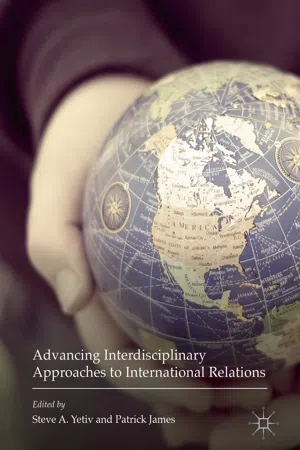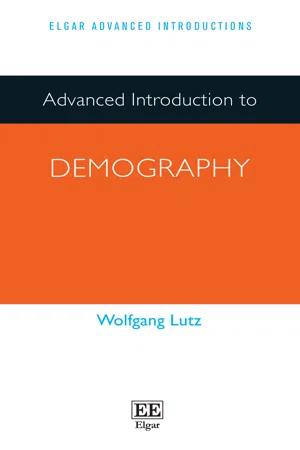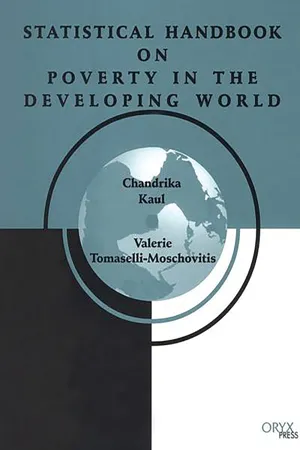Politics & International Relations
Demographics
Demographics refer to statistical data relating to the population and particular groups within it, such as age, gender, income, education, and ethnicity. In the political and international relations context, understanding demographics is crucial for analyzing voting patterns, public opinion, and social dynamics, and for formulating policies and strategies that cater to specific demographic groups.
Written by Perlego with AI-assistance
Related key terms
1 of 5
3 Key excerpts on "Demographics"
- Steve A. Yetiv, Patrick James, Steve A. Yetiv, Patrick James(Authors)
- 2016(Publication Date)
- Palgrave Macmillan(Publisher)
229 © The Author(s) 2017 P. James, S.A. Yetiv (eds.), Advancing Interdisciplinary Approaches to International Relations, DOI 10.1007/978-3-319-40823-1_8 CHAPTER 8 Demography and International Relations: Economics, Politics, Sociology, and Conflict Tadeusz Kugler T. Kugler () Politics and International Relations, Roger Williams University , Bristol, RI, USA e-mail: [email protected] Demography is an intrinsically dynamic field of study that shapes the very characteristics of a society, which in turn has implications for the causation of conflict and dynamics of international relations in general. Intelligent observers might well argue that world affairs at the core is about the peo- ple that populate the planet, but the field of IR has largely ignored this dimension of world politics, compared to other concerns, possibly because it falls at a sub-systemic level of analysis—an area of analysis that this book seeks to elevate with regard to the interdisciplinary study of IR. Yet, demographic studies allow for the analysis of fundamental structures of society and can significantly enhance our understanding of international relations and the causes of conflict. Structural patterns that produce the demographic transition, 1 youth bulges, 2 migrations, 3 gender imbalances, 4 and population size, 5 and density 6 result in large part from choices made by policy-makers. These patterns then have the potential to affect profoundly the stability of nations and other key issues of the international system. Economic pressures, political destabilization, and even the potential for conflict can be influenced by these dynamics and decisions. This chapter strongly suggests the pressing need for further development of the field of political demography with a special emphasis on its influence in the field of conflict studies. As such, it aims to sketch a truly interdisci- plinary approach to the study of IR, with some focus on conflict dynamics.- eBook - PDF
- Wolfgang Lutz(Author)
- 2021(Publication Date)
- Edward Elgar Publishing(Publisher)
While changes in the age structure are certainly highly relevant for many social and economic issues, there are also other highly relevant demographic dimensions. This overly narrow perspective on age and sex alone may have to do with the fact that many widely available population data and projections are often only pre- sented by age and sex. If this is what demographers typically present to the rest of the world, then the rest of the world may think this is all we have to offer. For this reason, here I try to emphasize examples of demographic analysis and projections that go beyond age and sex. The multi-dimensional understanding of demography underlying this volume is not only in line with the origin of the discipline and the writings of its most distinguished representatives, it also is in line with the way international media often write about demography. When they write about the changing Demographics of, for example, the American electorate, they do not just mean the changing age composition but also the changing composition by ethnicity, rural/urban place of residence, educational attainment, occupational groups, etc. Linguistically, the word demography is derived from the ancient Greek word “demos” which means the population, the aggregate of individuals living in a city state (“polis”) together with “graphein” which means ADVANCED INTRODUCTION TO DEMOGRAPHY 4 to write, draw or map (such as in geography). The word “demos” is the same word that is the basis for the more famous and better-known notion of democracy (the rule by the demos). While in ancient Greece this membership in the ruling demos was mostly restricted to free male citizens – thus leaving out all women, slaves and the so-called metics (landless migrants) – today demos is widely understood to include all citizens of both genders and all social groups. In ancient Greek political writing, the interests of the demos are often seen as opposed to that of the selfish individual “idiotes”. - Chandrika Kaul, Valerie Tomaselli-Moschovitis, Chandrika Kaul, Valerie Tomaselli-Moschovitis(Authors)
- 1999(Publication Date)
- Greenwood(Publisher)
D. Demographics GENERAL OVERVIEW The indicators included in this section outline the most basic human dimensions of poverty throughout the world: Demographics. They include such statistics as total popu- lation, population growth rates, population density, ur- ban population share, gender breakdowns, birth rates, share of population over age 60, death rates, and mortal- ity rates. These demographic statistics are indicators of the past, current, and projected characteristics of a population's structure—its size, its size in relation to land, its component ratios between young and old and male and female, its past growth trends, and its future growth prospects. Demographics help students, researchers, and policymakers analyze the current and potential impacts that a society's people have on its physical resources, environmental situation, social needs, and economic pros- pects. EXPLANATION OF INDICATORS Total Population: Total population in poverty studies is a double-sided indicator. It indicates the breadth of a society's human resources, but at the same time can rep- resent the scope of a country's responsibility towards its people. As it is a simple head count, it is most often used with other indicators to arrive at more sophisticated mea- surements, such as population density (land area divided by population) and gross domestic product per capita (GDP/capita), both of which add further dimension to a raw count of the people within the boundaries of an in- dividual country (D1.1-D1.4). Population Growth Rates: Growth rates in popu- lation show the change over a designated period of time in the size of a country's population. For the students and policymakers concerned with poverty, they are a cru- cial indicator of the pressure exerted on a country's natu- ral, economic, and social resources (health care and education, for instance).
Index pages curate the most relevant extracts from our library of academic textbooks. They’ve been created using an in-house natural language model (NLM), each adding context and meaning to key research topics.


